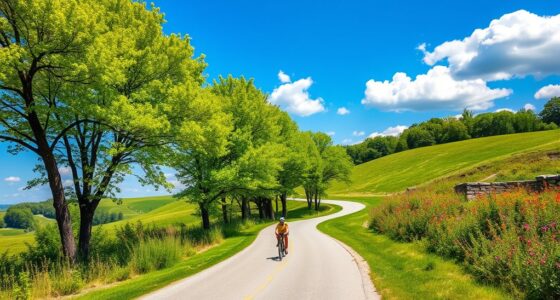Discover the Great Allegheny Passage (GAP) Trail, a 150-mile scenic route connecting Pittsburgh to Cumberland, Maryland. With its mostly flat terrain and stunning landmarks, you’ll enjoy cycling, hiking, or horseback riding. Don’t miss iconic sites like Point State Park and the Big Savage Tunnel. Plus, it’s great for fishing or leisurely rafting nearby. When you’re planning your adventure, there are important tips that can enhance your journey further. Keep exploring to see what awaits!
Key Takeaways
- The Great Allegheny Passage (GAP) is a scenic 150-mile trail connecting Pittsburgh, PA, to Cumberland, MD, and extending to Washington, D.C. via the C&O Canal Towpath.
- Enjoy a smooth riding experience on the mostly flat, crushed limestone surface, perfect for cycling, hiking, and horseback riding.
- Key landmarks include Point State Park, Fort Pitt Museum, and engineering marvels like the Big Savage Tunnel and Salisbury Viaduct.
- Accommodations range from hotels to hiker-biker campgrounds, making it easy to plan your overnight stays along the trail.
- The trail generates significant economic benefits, attracting nearly one million visitors annually and boosting local businesses in lodging and outdoor activities.
Overview of the Great Allegheny Passage

The Great Allegheny Passage (GAP) is a stunning 150-mile trail that stretches from Pittsburgh, Pennsylvania, to Cumberland, Maryland.
Discover the breathtaking 150-mile Great Allegheny Passage, connecting Pittsburgh to Cumberland amidst beautiful landscapes.
As you ride or hike along this mostly gravel path, you’ll appreciate its gentle grade, averaging less than 1%, making it accessible for everyone. You’ll encounter the highest point at the Eastern Continental Divide and enjoy the scenic beauty of Southwest Pennsylvania’s mountainous terrain.
Opened in sections since 1986 and completed in 2013, the GAP connects with the C&O Canal Towpath, offering an impressive 335-mile route to Washington, D.C.
Managed by the Great Allegheny Passage Conservancy and local trail groups, this trail is a testament to community effort and dedication to outdoor recreation.
Key Landmarks Along the Trail
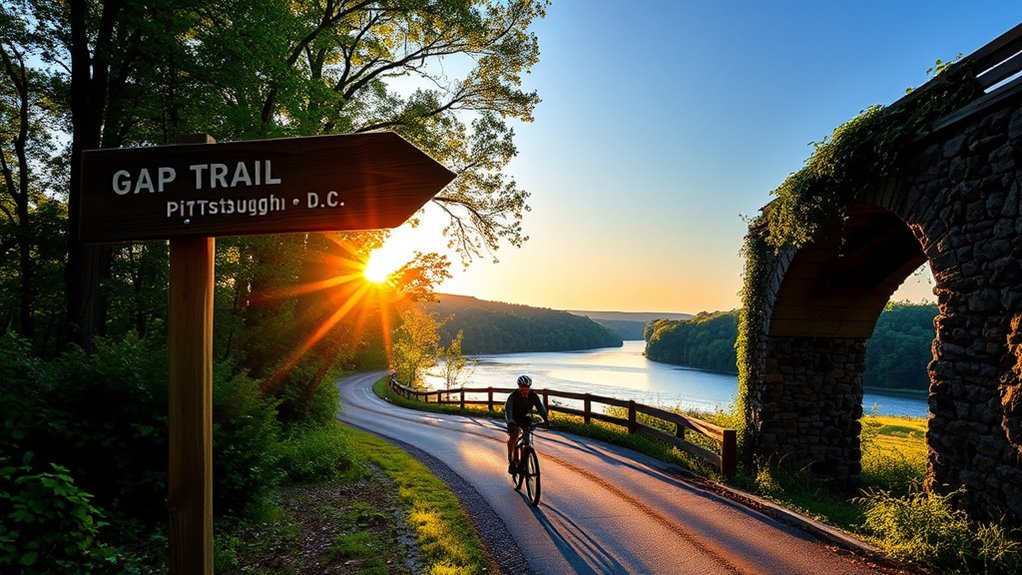
As you traverse the Great Allegheny Passage, you’ll encounter a rich tapestry of landmarks that highlight the region’s historical, cultural, and natural significance.
Begin at Point State Park, where three rivers converge, and explore the Fort Pitt Museum, which showcases Pittsburgh’s storied past.
Don’t miss the Pumphouse, a key site from the Homestead strike, or the Darr Mine Memorial, honoring a mining disaster.
Marvel at engineering feats like the Hot Metal Bridge and the Big Savage Tunnel.
Nature lovers will enjoy the sweeping views from the Salisbury Viaduct and the Big Savage Overlook.
Additionally, you’ll find cultural gems like Kennywood Park and Harpers Ferry, adding vibrant flavor to your journey along the trail.
Activities to Enjoy on the GAP
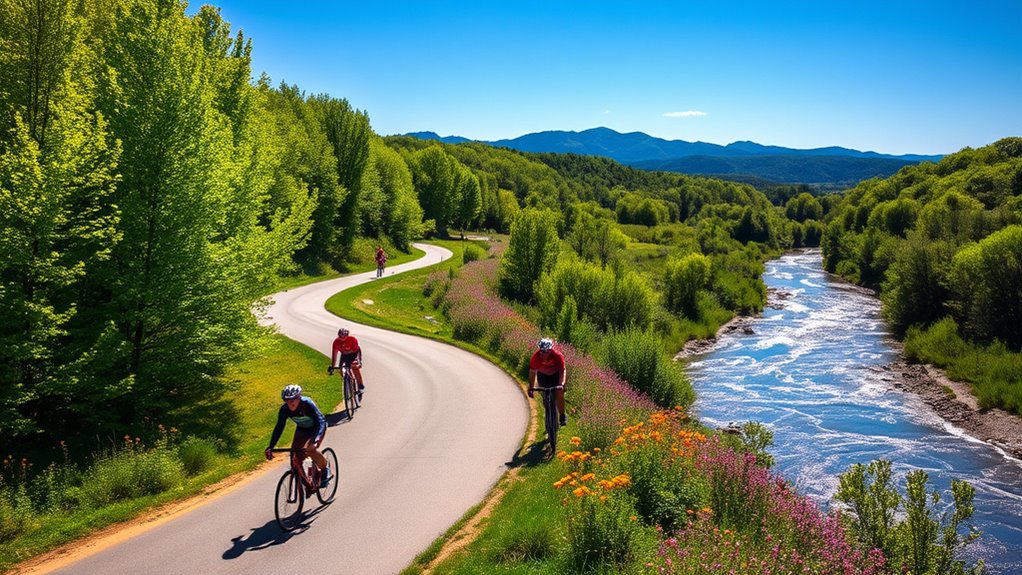
Whether you’re seeking adventure or relaxation, the Great Allegheny Passage (GAP) offers a variety of activities to suit every outdoor enthusiast.
You can cycle along the smooth, crushed limestone surface or explore the scenic hiking paths connected to the Laurel Highlands. Horseback riding is allowed on certain sections, while nearby rivers invite you to fish or raft, especially in Ohiopyle.
If you’re into rock climbing, Ohiopyle State Park has great walls to conquer. Don’t miss the chance to spot wildlife or discover stunning waterfalls.
In winter, cross-country skiing becomes a favorite pastime. Additionally, check out local festivals or races in trail towns to immerse yourself in the community spirit while enjoying the great outdoors!
Planning Your Trip: Logistics and Tips
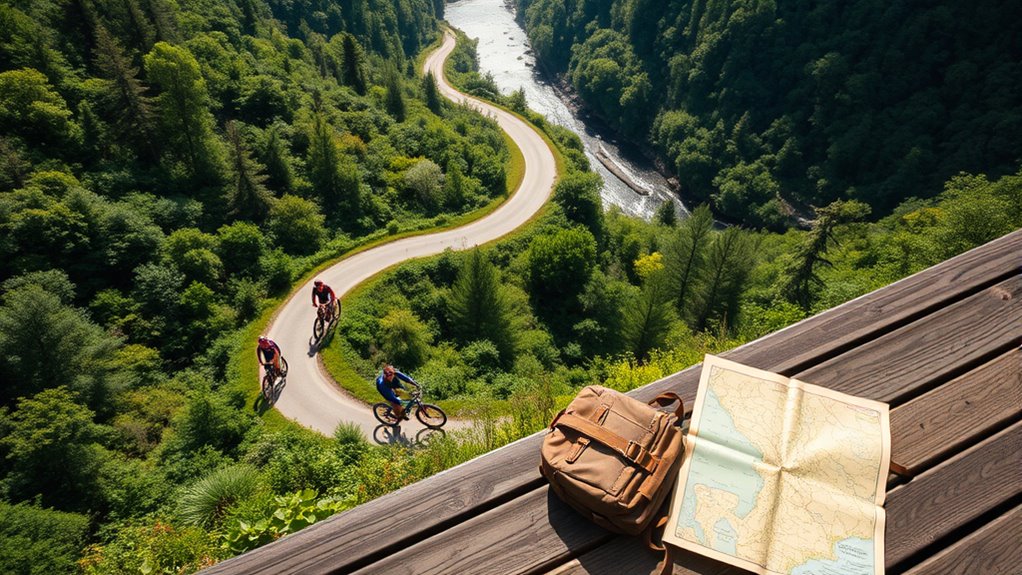
Planning a trip on the Great Allegheny Passage (GAP) involves a few key logistics to ensure a smooth experience.
Planning your Great Allegheny Passage trip requires key logistics for an enjoyable journey.
First, familiarize yourself with the trail’s 150 miles of mostly flat terrain, with the C&O Canal Towpath adding another 185 miles.
Remember to pack essential gear, including appropriate clothing and bike tools. Accommodations range from hotels to hiker-biker campgrounds, so plan where you’ll stay.
Consider transportation options; Amtrak and private shuttles can help with bike transport. Check the weather forecast for varying conditions and maintain physical conditioning for endurance.
Lastly, bring a bike lock and stay aware of road crossings for your safety. By planning ahead, you’ll enjoy a memorable adventure on the GAP!
The Impact of the GAP Trail on Local Communities
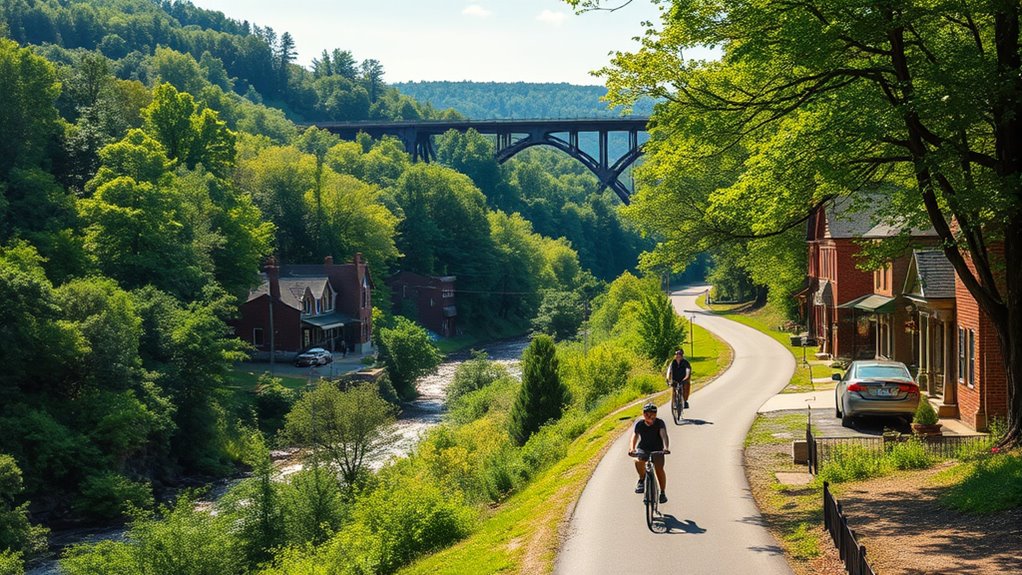
The GAP Trail has significantly transformed local communities, breathing new life into areas once dominated by industrial decline. It generates over $121 million annually, driving local economies through direct spending and supporting nearly 1,400 jobs. As property values have surged by 13% between 2015 and 2019, local businesses in lodging, dining, and outdoor activities thrive due to increased tourism. The trail fosters community engagement through local events, creating vibrant identities for former industrial towns. With nearly 1 million visitors each year, the trail attracts enthusiasts from across the country and beyond, enhancing infrastructure and services. Additionally, the trail’s community engagement initiatives mirror successful strategies seen in places like Wichita, where local festivals promote cultural vibrancy.
Frequently Asked Questions
What Is the Best Time of Year to Visit the GAP Trail?
The best time to visit the GAP Trail is during spring or fall.
In spring, from late April to early June, you’ll enjoy blooming plants and mild temperatures.
Fall, from September to mid-October, offers stunning foliage and crisp weather.
Summer’s warm and dry, but accommodations can fill up quickly.
Winter isn’t ideal due to freezing conditions.
Are There Any Fees or Permits Required to Use the Trail?
Fees and permits play a pivotal part in your plans for the trail.
If you’re part of a group larger than 25, you’ll need a permit, costing $25 for a one-time application or $50 for a year. Non-profits might dodge fees.
Don’t forget that commercial activities require a Commercial Use License, complete with insurance.
Can I Bring My Dog on the GAP Trail?
Yes, you can bring your dog on the GAP Trail. Just make sure you keep your pup on a leash at all times, and it shouldn’t cross the trail’s width.
You’ll need to clean up after your dog and pack out any waste. Be mindful of other trail users, especially cyclists, and keep your dog under control to avoid accidents.
Enjoy your outdoor adventure together while following these simple rules!
What Type of Bike Is Best for Riding the GAP?
You might think any bike will do, but choosing the right one can make or break your experience on the GAP.
Hybrid bikes offer comfort and versatility, while gravel bikes excel on unpaved sections.
Touring bikes are perfect for long hauls with gear, and mountain bikes handle rough patches but can feel cumbersome on smoother trails.
Ultimately, aim for a bike with at least 28 mm tires and multiple gears to tackle those varied terrains!
Is There Cell Phone Reception Along the Entire Trail?
Cell phone reception along the trail isn’t consistent.
You’ll find limited coverage in many areas, especially in mountainous sections. Verizon usually provides the best service, but even that can be spotty.
To improve your chances of getting a signal, head to higher points or major road crossings.
It’s smart to check carrier maps beforehand, inform someone about your plans, and consider alternative communication options for emergencies.
Conclusion
As you explore Pennsylvania’s GAP Trail, you’re not just enjoying stunning scenery; you’re also contributing to local communities. Did you know that the trail generates an impressive $40 million annually in tourism revenue? This means every pedal or step you take helps support small businesses and preserves the natural beauty around you. So, lace up your hiking boots or hop on your bike—discover the adventure that awaits on this remarkable trail from Pittsburgh to D.C.!




